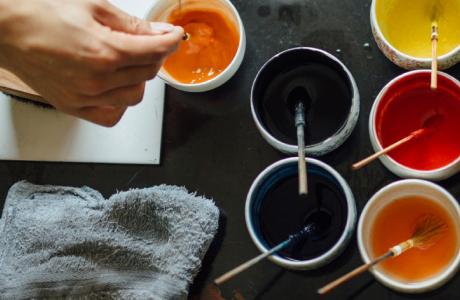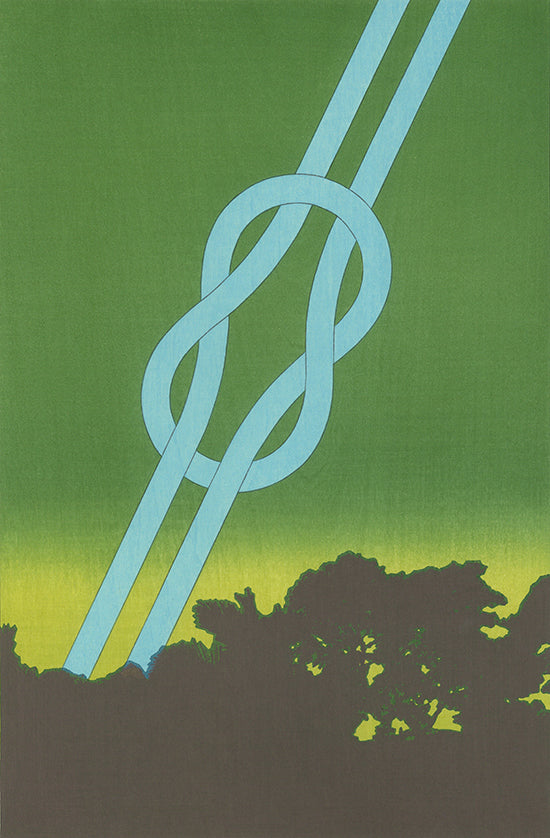








A set of 6 designs of Ikko Tanaka "Rope"
Rope is one of the motifs that Ikko Tanaka worked on repeatedly, mainly in the 1970s. The rope takes a form resembling mizuhiki (a traditional Japanese artform of knot-tying) and evokes the traditional Japanese “knot” culture. Apart from his main field of work, Tanaka called his own printmaking work "graphic art" and made it his lifework. What he attempted in the woodcut print "Rope" series was a combination of deformed ropes and silhouettes of landscape photographs. They are works that allow you to see various expressions unique to woodcut prints in a single piece. Regarding this series, the late Keizaburo Yamaguchi, an ukiyo-e researcher, said, “In free imagination, abstract ropes and concrete landscapes skillfully alternate to create a mysterious feeling within a modern sensibility.”
| Material | Paper: Echizen Kizuki Hosho Washi made by Living National Treasure, Ichibei Iwano |
| Feature | Type of print: Woodcut print |
[Contents]
1. Rope:Lake
2. Rope:Field
3. Rope:Sky
4. Rope:City
5. Rope:Forest
6. Rope:Road
Original Box: 40.5×29.0×1.8 cm (external size)
with one free frame
The order for domestic destination(inside of Japan) is shipped by Yamato Transport and international destination (outside of Japan) is shipped by either FedEx or Japan Post's EMS (Express Mail Service).
Domestic Shipping (Inside of Japan)
Yamato Transport Co., Ltd.
You can choose the delivery date and time window. Shipping fee is 700 yen for any destination inside of Japan.
<Free Shipping Service>*Domestic destination only
Free Shipping is available when a total of purchase is over 50,000 yen (for one destination) .
If you would like to choose the delivery date and time window, please fill the column of "Request of Delivery Date". Please note that only the date five business day after your order can be chosen and also this service might be canceled under some circumstances. Please ask us for details.
International Shipping (outside of Japan)
FedEx
Delivery dates are varied depending on the destination countries and areas.
EMS international shipping service may be used for the area which has no or limited FedEx delivery.
Actual shipping fee will be charged for the international delivery. (No free shipping over 50,000 yen purchase is applied for the international shipping.)
*No shipping is available on weekends.
Estimated Fee and delivery time
Area A : East Asia / Southeast Asia
Area B : North America / Indonesia
Area C : Europe / Middle East
Area D : Australia / New Zealand
Area E : South America / Africa / Other Areas
| Area | Delivery time | 1-5 Unframed Prints | One Framed Print |
|---|---|---|---|
| A | 3-6Days | ¥3,600 | 5,300 |
| B | 4-6Days | ¥4,000 | ¥6,000 |
| C | 4-7Days | ¥4,400 | ¥7,000 |
| D | 4-7Days | ¥6,500 | ¥8,000 |
| E | 4-7Days | ¥7,500 | ¥13,500 |
*Please read notes about international shipping
Customs
Please note that the customs may be charged to the consignee during the international shipping process. The customs' manner and fee are various depending on the country where the delivery destination is and the purchaser is required to be responsible for anything regarding customs. The purchaser is considered to agree with being responsible for customs when you place an order.
*FedEx offers the service to charge the custom to a purchaser (not a consignee) after the fee is fixed for the destination country. This service is useful when you would like to ship the item as a gift and do not want the consignee to pay for the custom. Please request us if you would like to use this service.

Adachi's Philosophy and Mission
At Adachi Institute of Woodcut Prints, we create attractive works that are in keeping with the times while maintaining the basics of traditional woodcut printing techniques.

Adachi's Meticulous Quality and Materials
At Adachi Institute of Woodcut Prints, we use carefully selected materials and tools to bring out the original beauty of woodcut prints to the fullest.

Traditional Techniques and Adachi's Artisans
The production of ukiyo-e, which developed as a commercial printing method, focused on efficiency and profitability. And so, all processes are streamlined and sophisticated. We will introduce the basics of ukiyo-e techniques through the production process of Katsushika Hokusai's masterpiece "The Great Wave off Kanagawa."














